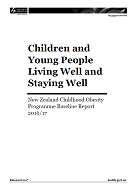
This report was developed in collaboration with the Ministry of Education, Sport New Zealand, the Ministry for Primary Industries and the Health Promotion Agency. The report builds on the work that these organisations did in 2016 to develop an intervention logic model for reducing childhood obesity, which includes a set of 15 performance indicators that we will use to monitor the New Zealand Childhood Obesity Programme over the next five years.
The report includes a description of each of the indicators and presents a baseline view of their performance. It also provides a brief overview of the New Zealand Childhood Obesity Programme and an update on the programme’s first year of implementation (2015/16).
This report will form the basis of future monitoring reports on the New Zealand Childhood Obesity Programme. The first monitoring report will be published in 2018 and will provide information on the second year of implementation (2016/17) and updated performance against the reducing childhood obesity indicators.
Reducing childhood obesity indicators
| Indicator | Measure | |
|---|---|---|
| 1 | Time spent watching television, videos or screens | Percentage of children (aged 2–14 years) who usually watch two or more hours of television (including DVDs and videos) per day |
| 2 | Sleep duration | Percentage of children (aged 5–13 years) who get 9–11 hours of sleep per day on average |
| 3 | Time spent on physical activity | Percentage of children (aged 5–17 years) who spent at least one hour per day being physically active (for sport, physical education, exercise or fun) over the last week |
| Indicator | Measure | |
|---|---|---|
| 4 | Breastfeeding | Percentage of infants who are exclusively or fully breastfed at two weeks, six weeks and three months Percentage of infants who are still receiving breast milk at six months |
| 5 | Consumption of fast foods | Percentage of children (aged 2–14 years) who ate fast food at least once in the past week |
| 6 | Consumption of sugary drinks | Percentage of children (aged 2–14 years) who had fizzy drink three or more times in the past week |
| 7 | Fruit and vegetable intake | Percentage of children (aged 2–14 years) who eat at least two servings of fruit each day Percentage of children (aged 2–14 years) who meet New Zealand’s age-specific vegetable intake guidelines |
| Indicator | Measure | |
|---|---|---|
| 8 | Awareness of the Health Star Rating system | Percentage of grocery shoppers who recognise the Health Star Rating system when prompted Percentage of grocery shoppers who understand the Health Star Rating system Percentage of grocery shoppers who use the Health Star Rating system when shopping |
| 9 | Active transport to and from school | Percentage of children (aged 5–14 years) who usually use an active mode of transport, such as walking, biking or skating, to get to and from school |
| 10 | Use of a bike | Percentage of children (aged 5–17 years) who have ridden a bike in the last week for sport, exercise or fun Average number of hours children (aged 5–17 years) spent riding a bike in the last week for sport, exercise or fun |
| 11 | Water in schools | This measure is still under development |
| Indicator | Measure | |
|---|---|---|
| 12 | Body mass index | Percentage of children (aged 2–14 years) with a BMI that indicates they are thin, a healthy weight, overweight (but not obese) or obese |
| 13 | Gestational diabetes | Percentage of births where the mother had gestational diabetes |
| 14 | Raising Healthy Kids health target | Percentage of obese children identified in the B4 School Check programme who were offered a referral to a health professional for clinical assessment and family-based nutrition, activity and lifestyle intervention |
| 15 | Birth weight | Percentage of babies whose birth weight (kg) was extremely low, very low, low, normal or high |
